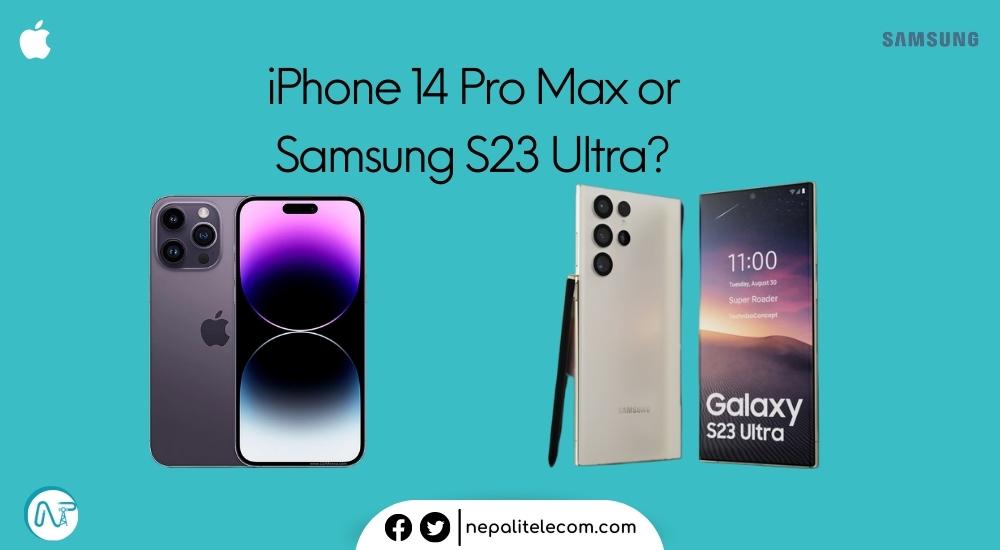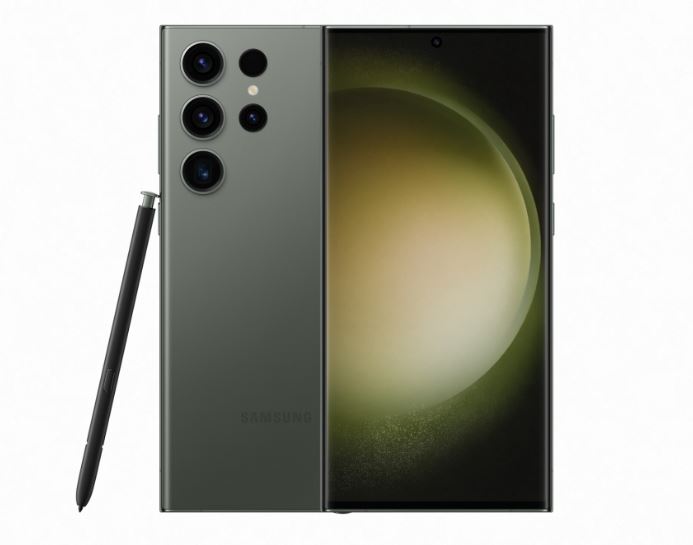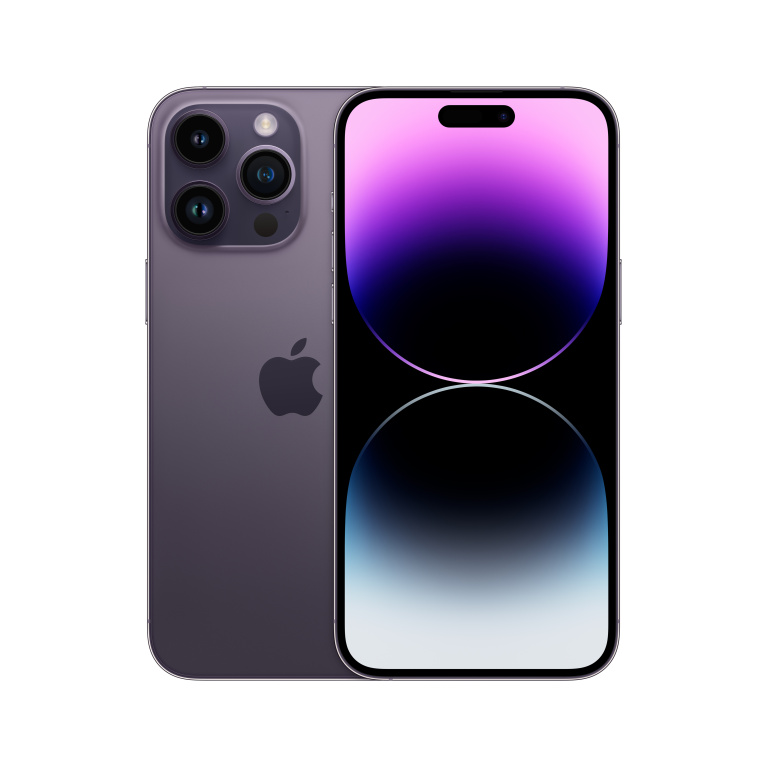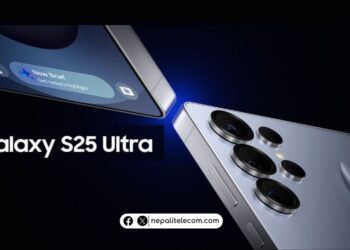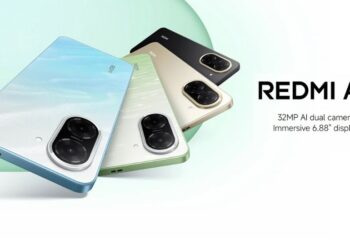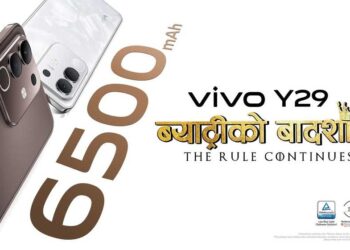The battle of Samsung Galaxy S23 Ultra vs iPhone 14 Pro Max has begun with both leading smartphone giants having launched their greatest-to-date phones. Equipped with all the possible hardware and software, they bring users the most elevated user experience possible. And both continue to be equally loved by fans for their different UIs, SoCs, design, and all the superlative specs cramped on them. In this post, we pit the two devices’ specs against each other to see how they fare in the “battle of the bests”.
Overview (Samsung Galaxy S23 Ultra vs iPhone 14 Pro Max)
Cupertino giant Apple launched iPhone 14 series back on September 16 while the South Korean brand Samsung launched its highly anticipated Galaxy S23 series on February 17. Both 5G compatible premium phones are the most-talked devices of the year due to their specs and equally corresponding capabilities. Here, we draw a comparison between the two best phones based on their design/display, performance, battery capacity and charging technology, etc.
Design & Display
The biggest design aspect of the iPhone 14 Pro Max is the introduction of the “Display Island”, a pill-shaped notch that houses a selfie shooter and space for other notifications, alerts, and info. In terms of size, it’s a 6.7-inch display beast with a 120Hz refresh rate. It reaches 2000 nits for brightness. A 2776 x 1290 pixels resolution with 460 PPI on an OLED display serves one of the best visuals on the screen.
The Always-On display is another lauded feature of the phone. It uses low power and shows time, widgets, date, and notifications. The feature has been there on Android for years but this one has garnered wide praise for users and reviewers alike.
Samsung’s Galaxy S23 Ultra is slightly taller stretching at 6.8-inch just like the previous Galaxy S22 Ultra and comes with a Dynamic AMOLED 2X display. The resolution of 1440 x 3088 pixels. Like the Apple counterpart, it gets a similar 120Hz refresh rate for smooth screen touches. The slightly larger screen means it has a few more pixels per inch at 501. The S23 Ultra has no stretched-out Display Island but retains a traditional-looking selfie camera in the middle.
Galaxy S23 Ultra is slightly larger than iPhone 14 Pro Max and hence has more PPI. But both run on OLED displays so the images are going to be vibrant and colorful. At the same time, both possess the same 120Hz refresh rate for scrolling. The minor resolution differences are negligible so to speak. The differentiation is down to individual preference.
The S Pen on S23 Ultra is a good deal!
It should be mentioned that the S23 Ultra carries a built-in S Pen that supports Screen Off Memo, Quick Notes, Screen Write, etc. The nostalgia-hitting feature continues from the last year’s S22 Ultra which was a signature aspect of the now-phased-out Galaxy Note series. For lovers of an extra touch hand, they will love the S Pen inclusion, however, for Apple users, it’s not available on any of the models. So we are calling it an advantage to S23 Ultra. But again, it’s deeply a personal choice.
Processor
iPhone 14 Pro Max is powered by Apple’s next-generation A16 bionic chip which comes off a 4nm architecture. It has a 6-core CPU configuration mated to the company’s homegrown 5-core GPU which it says offers 50 percent more memory bandwidth. The Cupertino-based giant also claims that A16 bionic chip is 40% more powerful than anything in the industry. Further, the 16-core Neural Engine can run 17 trillion operations a second.
Samsung S23 Ultra boasts a similarly powerful, if not more, SoC in Snapdragon 8 Gen 2 for performance. Unlike iPhone 14 Pro Max, it’s an octa-core CPU paired with an Adreno 740 GPU to handle all the games and the graphics of the phone. The company claims the GPU is 41% faster and the CPU 34% faster than their immediate predecessors. S8G2 is the most powerful mobile platform developed yet.
With SoCs like these, both phones should handle the most graphics-heavy tasks you push through it be it games or apps. We highly doubt that they are inferior to each other by a huge margin. So, whichever smartphone platform you are on, you should be just fine with your phone’s gigantic prowess under the hood.
Camera
Specs-wise, Galaxy S23 Ultra’s camera wins the battle hands down. The premium phone gets a monstrous 200 MP wide-angle camera with an f/1.7 aperture in a quad-camera setup. More pixels imply that photos will retain more details, and be extra sharp. The other camera includes a 12 MP ultra-wide, 10 MP 3X telephoto, and another 10 MP tele with 10x optical zoom. The OIS also accentuates photography with better control of images. The S23 Ultra cameras are more focused on uplifting night photography so during low-light conditions, you would still be getting good stills than previous generation phones offered. It can record videos up to 8K res at 30fps.
However, in the DxOMark rating of the Samsung S23 Ultra, the device tied for 10th ranking with the Google Pixel 7 and Vivo X90 Pro+.
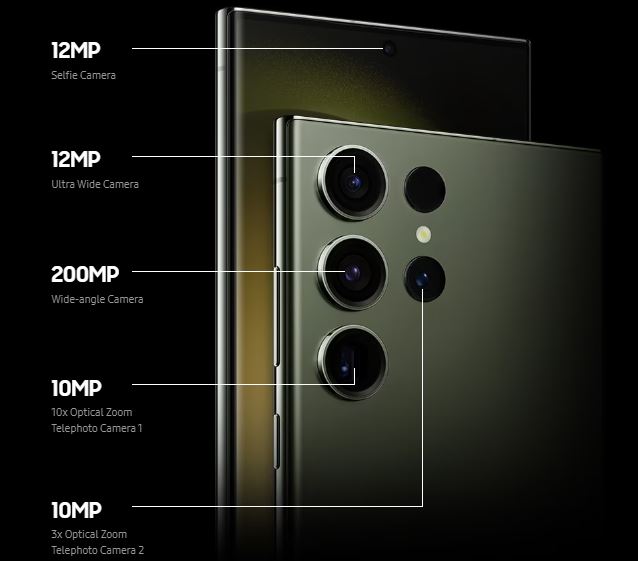
iPhone 14 Pro Max has also bumped its camera specs this year by introducing a 48 MP camera. It comes with an f/1.8 aperture and dual-pixel PDAF. Similarly, the camera uses sensor-shift OIS technology to shoot images with stability. The other camera includes a 12 MP telephoto sensor, and a 12 MP ultra-wide sensor to capture a wider field. Features such as Night mode, Photographic Styles to personalize, Apple ProRAW, etc. elevate photography on the luxurious phone.
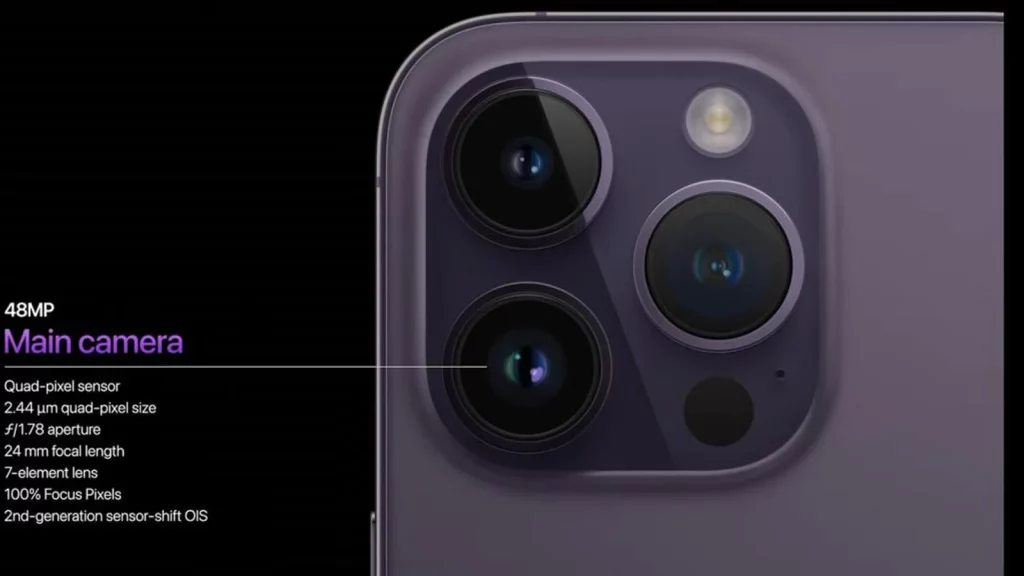
For selfies, Galaxy S23 Ultra gets a 12 MP selfie camera coming with f/2.2 aperture. Surprisingly, Samsung decided to downgrade the front camera from S22 Ultra’s 40 MP selfie camera. Its counterpart iPhone 14 Pro Max also gets a 12 MP selfie camera with f/1.9 aperture which Apple calls Truedepth front camera. It also serves as a FaceID sensor. The camera has improved autofocus and low-light camera efficiency. For specs geek, the front camera is able to shoot up to 4K at 60 fps.
Battery and charging and connectivity
iPhone 14 Pro Max carries a decent 4323 mAh battery which Apple says lasts longer than those in previous generation phones. It supports 20W fast charging, 15W wireless MagSafe charging, and 7.5W Qi wireless charging.
Samsung Galaxy S23 Ultra comes with a slightly larger 5000 mAh battery. It supports up to 45W of wired fast charging and 10W wireless charging. While it is also compatible with PD3.0. Samsung says the S23 Ultra can charge up to 65% in 30 minutes. The fast charger though doesn’t come in the box.
Head to head, Galaxy S23 Ultra beats iPhone 14 Pro Max in battery depart but what lacks in the mere numbers is compensated by optimization. Manufacturers produce phones in such a way that every component from the display, to SoC, and optics complements each other. The Pro Max having lesser battery capacity should be negligible in that regard. However, we can’t deny the theoretical advantage here.
Also read: Best Flagship phones in Nepal
Connectivity
Both Galaxy S23 Ultra and iPhone 14 Pro Max support 5G connectivity, eSIM, and NFC. They also support WiFi 6 for wireless broadband service. Samsung’s flagship device supports Bluetooth 5.3, A2DP, Le, GLONASS, USB Type C3.2, etc. Bixby brings natural language commands and dictation too. Apple’s iPhone 14 Pro Max likewise, supports Emergency SOS via satellite, and Ultra Wide Bank support for a superfast 5G experience.
Check out: 5G in Nepal | Features, Spectrum, Trial with Ntc, Ncell
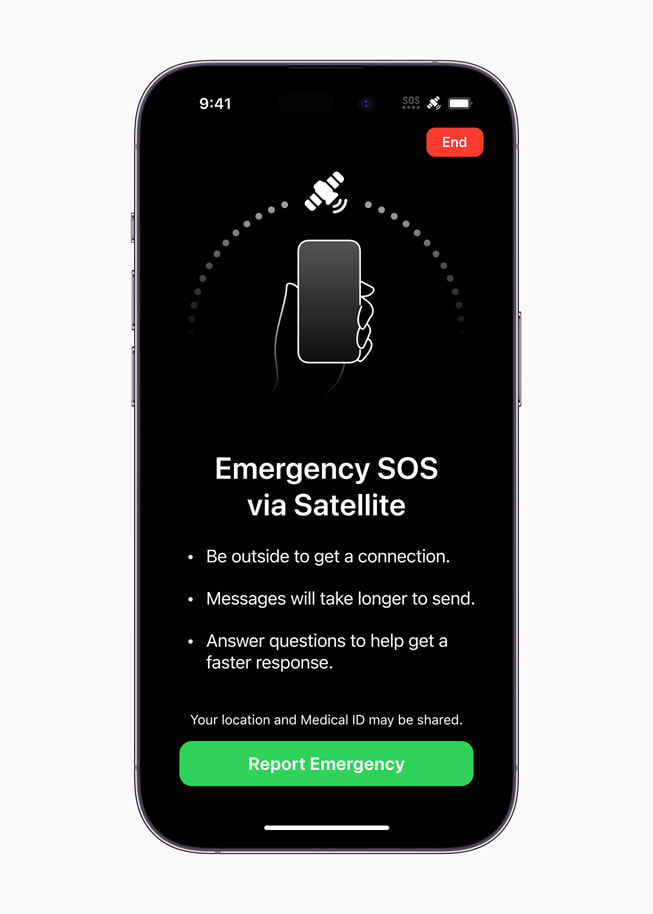
Noticeably, Galaxy S23 Ultra skipped the expected satellite communication. Apple has reportedly saved lives with its emergency feature allowing people to send SMS in critical conditions. We can expect the South Korean company to integrate the feature in next year’s successor. For now, apple has a crucial advantage with its wireless satellite connectivity feature. Read this: Samsung announces two-way satellite connectivity for smartphones
Storage
With growingly advanced SoC and optics, photos and videos are going to take a huge chunk of storage. To address this, both manufacturers have been offering huge storage options in recent years which is no exception with the current generation phones either. Samsung offers a range of options in terms of RAM and internal storage. You can buy an S23 Ultra phone with either 8 GB, or 12 GB RAM with the option of internal storage from 128 GB, 256 GB, 512 GB, to 1 TB and support UFS 4.0.
iPhone 14 Pro Max comes with 6 GB of RAM and a maximum of 1 TB of NVMe storage. You can also choose from 128 GB, 256 GB, or 521 GB of internal storage depending on your storage needs.
The 2 GB less RAM on iPhone shouldn’t discourage you from buying the Pro Max phone though. iPhones have been traditionally marked for being smooth despite their low specs and it has to do with how it is differently structured than Android. Anyway, the 6 GB RAM is not a slim number either.
OS platforms
iPhone 14 Pro Max runs on iOS 16 out of the box. It brings the battery indicator back which was missing since iPhone X. The latest OS brings haptic feedback to its keyboard allowing users to feel low vibration while typing. Always-On display and a customizable lock screen are other new features that come with it.
On the other hand, the Samsung Galaxy S23 Ultra 5G runs on Samsung’s One UI 5.1 which is based on Android 13. A new dynamic weather widget, and integration of Samsung Notes with Google Meet, allow users to share and edit notes and collaborate during video conferences with ease. The skin also allows users to browse pages on their Samsung Internet app on their PCs. It’s not a major update however, brings a few cool features to engage users.
OS is one of the factors which divide smartphone users’ preference for brands. iOS is a close source and Android is free to all. But both have their unique signature feel and remain key to user experience. It’s up to you to decide which one is your favorite.
Find more: Stock ROM vs Custom ROM, Which One is Better?
Samsung Galaxy S23 Ultra Specfication
- Dimension: 163.4 x 78.1 x 8.9 mm (6.43 x 3.07 x 0.35 in)
- Weight: 234 g (8.25 oz)
- Display: a 6.8 inches QHD+ Dynamic AMOLED 2X display, 1440 x 3088 pixels resolution, 20:9 aspect ratio, 120Hz refresh rate, 240Hz Touch Sampling Rate in Game Mode, Vision booster, Enhanced comfort, HDR10+, 1750 nits (peak brightness), Always-on display, Corning Gorilla Glass Victus 2, IP68 Water Resistance
- Processor: Qualcomm Snapdragon 8 Gen 2 processor
- CPU: Octa-core (1×3.36 GHz Cortex-X3 & 2×2.8 GHz Cortex-A715 & 2×2.8 GHz Cortex-A710 & 3×2.0 GHz Cortex-A510)
- GPU: Adreno 740
- RAM: 8GB/12GB of RAM.
- Memory: 256GB/512GB/1TB UFS 4.0 internal storage
- Software: Android 13 OS, One UI 5.1
- Rear Camera: Quad rear Camera Setup
- 200 MP primary sensor, f/1.7 aperture, 0.6µm, PDAF, Laser AF, OIS
- 10 MP periscope telephoto sensor, f/4.9 aperture, 1.12µm, dual pixel PDAF, OIS, 10x optical zoom
- 10 MP telephoto lens, f/2.4 aperture, 1.12µm, dual pixel PDAF, OIS, 3x optical zoom
- 12 MP Ultra Wide-angle lens, f/2.2 aperture, 120˚Field OF View, 1.4µm, 1.4µm, dual pixel PDAF, Super Steady video
- Rear Video: up to 8K@24/30fps, 4K@30/60fps, 1080p@30/60/240fps, 720p@960fps, HDR10+, stereo sound rec., gyro-EIS
- Front Camera: 12 MP selfie camera, f/2.2 aperture, 26mm (wide), 0.7µm, PDAF
- Front Video: up to 4K@30/60fps, 1080p@30fps
- Battery: Non-Removable Li-Po 5,000mAh battery with 45 W fast charging support, 10W wireless charging (Qi/PMA), 4.5W reverse wireless
- Colors: Phantom Black, Green, Cream, and Lavender
- Sensor: Magnetic induction sensor, Light sensor, Proximity Sensor, Gyro-meter, Acceleration sensor.
- Biometrics: Fingerprint (Ultrasonic Under Display Fingerprint Scanner) & Face Unlock (Software-Based)
- Security: Samsung Knox, Samsung Knox Vault
- Network: 5G
- Connectivity: Nano-SIM and eSIM or Dual SIM (2 Nano-SIMs and eSIM, dual stand-by), Wi-Fi 802.11 a/b/g/n/ac/6e, tri-band, Wi-Fi Direct, Bluetooth 5.3, A2DP, LE, GPS, GLONASS, BDS, GALILEO, NFC, USB Type-C 3.2, OTG, loudspeakers with stereo speakers, S-Pen, etc.
Apple iPhone 14 Pro Max Specification
- Dimension:
- 160.7 x 77.6 x 7.85 mm
- Weight:
- 240 grams [14 Pro Max]
- Display: Super Retina XDR display with ProMotion
- 6.7‑inch (diagonal) all‑screen OLED display, 2776 x 1290-pixel resolution at 460 PPI
- Dynamic Island Notch
- ProMotion technology with adaptive refresh rate, 1Hz-120Hz
- 1000 nits max brightness (typical); 2000 nits max brightness (HDR)
- Scratch-resistant ceramic glass, Fingerprint-resistant oleophobic coating, Always On Display
- HDR 10+ as well as Dolby Vision Support
- True Tone technology, Wide color (P3), Haptic Touch
- Chipset: A16 Bionic, Hexa-Core CPU
- GPU: 5‑core GPU
- Storage: 128GB / 256GB / 512GB / 1TB, NVMe
- Software: iOS 16
- Rear Camera: Triple
- 48 MP, f/1.5, 1.22µm, dual pixel PDAF, sensor-shift OIS
- 12 MP Ultra-wide, f/1.8, 120˚, 1.4µm
- 3x optical zoom, 12 MP Telephoto, f/2.8, 77mm, OIS,
- TOF 3D LiDAR scanner (depth)
- Adaptive True tone LED flash
- Rear Video: 4K@24/25/30/60fps, 1080p@25/30/60/120/240fps, 10‑bit HDR, Dolby Vision HDR, ProRes, Cinematic mode.
- Front Camera: 12 MP, f/1.9 aperture, 23mm, 1/36″
- Video: 4K@24/25/30/60fps, 1080p@30/60/120fps, gyro-EIS
- Battery: Li-ion, Nonremovable
- Charging:
- USB Power Delivery 2.0
- 20W fast charging
- MagSafe wireless charging 15W
- Qi magnetic fast wireless charging 7.5W
- Colors: Space Black, Silver, Gold, Deep Purple
- Sensor: Barometer, Three‑axis gyro, Accelerometer, Proximity sensor, Ambient light sensor
- Security: Face ID
- Network: 5G
- Connectivity: Dual SIM (nano‑SIM and eSIM), Dual eSIM (US region Only), 5G (sub‑6 GHz and mmWave), Wi‑Fi 6 (802.11ax), Gigabit LTE with 4×4 MIMO LAA, Bluetooth 5.3, Ultra-Wideband chip, NFC, and Express Cards, GPS with GLONASS, GLONASS, Galileo, QZSS, and Beidou, Lightning, USB 2.0, Stereo speakers, Emergency SOS via satellite (SMS sending/receiving), Car Crash Detection, etc.
Verdict
Samsung Galaxy S23 Ultra and iPhone 14 Pro Max both are superlative phones with the best specs. For loyal fans, both remain worthy of an upgrade whereas those trying to switch will have a hard time deciding between the two. Meanwhile, it also depends on you whether you want to buy either of these phones or rather wait for the next one for a more refreshing experience. Come September, you will have another iteration of the Apple phone which is the iPhone 15 series with USB type C, a powerful processor, and a more zoom camera. Similarly, you will have to wait till Feb 2024 to get your hands on the S24 series.
Availability
Samsung S23 Ultra is now available for purchase in Nepal. The 8GB/256GB variant costs Rs 191,999 while the 12GB/512GB variant comes for 209,999. Similarly, iPhone 14 Pro Max is also available to buy here. There are four variants up for sale with a slashed price as mentioned below.
| Samsung S23 Ultra Variant | S23U Price in Nepal | iPhone 14 Pro Max Variant | iPhone 14 PM Price in Nepal |
| NA | – | 128GB | Rs 2,07,990 |
| Samsung Galaxy S23 Ultra 5G (8/256GB) | Rs. 1,91,999 | 256GB | Rs 2,26,990 |
| Samsung Galaxy S23 Ultra 5G (12/512GB) | Rs. 2,09,999 | 512GB | Rs 2,65,990 |
| NA | – | 1TB | Rs 3,04,990 |
Do Check:- Apple iPhone Price in Nepal
If we compare the price for the respective storage variant, iPhone 14 Pro Max is more expensive by 25 thousand for 256GB and by more than 55 thousand for 512GB. But the price difference should not affect you much if you are already spending more than 2 lakhs for the premium phones, which makes you prefer one over the other.
Also, Check:- Samsung Mobile Price in Nepal
So, that was all about the comparison. Do you find a clear winner in the Galaxy S23 Ultra vs iPhone 14 Pro Max battle? Which one would you prefer and why? Do leave a comment below with your thoughts, views, and opinions.


